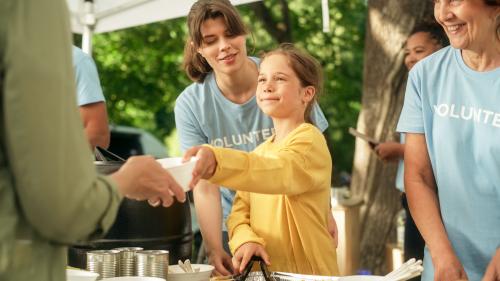Our lives are busy, but it is nice to slow down and reflect on our blessings occasionally. In our family, we go around the table and say something we are grateful for. This is a fun exercise that teaches our children to show gratitude for things otherwise taken for granted. We may not remember to do this exercise every day, but setting aside the time even once a week can make a big impact on your family. Here are some other ideas to help encourage gratitude in your children:
Model gratefulness
The easiest and most effective way to start teaching your children gratitude is to model it yourself. Let your children hear you talk about the things you are thankful for. “I am so grateful for this beautiful day today so that we can go to the park.” or “I am so thankful for a great job to pay for our home and our food.” When kids acknowledge the blessings they have in their lives, they will begin to take note and appreciate them.
Serve as a family
Families who do service projects together tend to be families who appreciate what they have more. When children see that some are less fortunate, they will develop a desire to help others and make a difference. Not only do they become more aware of others and the blessings in their own lives, but they are more likely to give of their time and treasures for a lifetime.
Teach them to say thank you
From a young age, teach children to say thank you. Encourage kids to say thank you for any acts of service or gifts. Even toddlers can be taught to sign “Thank you.” Writing thank you notes is a great way to provide kids the opportunity to thank someone for the gifts they receive and the time it took to purchase them. Encourage an “It’s the thought that counts” policy and explain that it isn’t the actual gift itself but the thought behind the purchase that we are grateful for.
Take care of property
Teach kids the value of their property by showing them the importance of caring for their belongings. Clothes cost money, so they should not be on the floor in piles. Toys cost money, so if one is broken due to misuse, do not rush to replace it.
Say no
It isn’t healthy to say yes to every request your child has. An answer of “No.” or “Not right now.” teaches children both the value of delayed gratification and encourages gratefulness for occasional treats. If a child is allowed to purchase a toy every time he visits the store, this will become expected. If the toy is purchased as a special reward or with their own money, the child will appreciate it much more.
Teach them the cost of things
Parents know everything costs money, and it adds up fast. Allow your child to come along to the grocery store and have them help you find the best deal on food they would like to purchase, or allow them to bring their own allowance and purchase something they would like. Point out how much it costs when you go out to eat as a family or make a large purchase of groceries or other items the family needs. Take care to avoid blaming or anger when discussing the cost of items and use the opportunity to teach. When children understand the true cost of items, they are more likely to appreciate the purchase in the first place.

Give them chores
When children have chores and responsibilities to their families, they begin to understand how much work goes into cleaning, yard work or other household tasks. Some families may choose to give an allowance for tasks completed, which can help kids learn to budget and understand the value of hard work and, in turn, develop gratitude for the work that others do.
The main thing to remember as you encourage gratefulness in children is to model the behavior. Thank them for their hard work, acknowledge and thank others for their acts of service, help kids understand the value of items and give them responsibilities that teach them hard work. Become intentional with your children, teach them the value of things and services and to slow down and appreciate the little things around them that may otherwise go unnoticed. Soon they will develop a habit of gratitude.









